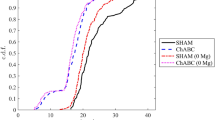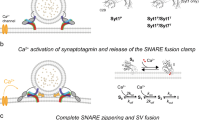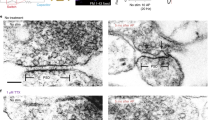Abstract
THE quantal theory of transmitter release proposed by del Castillo and Katz1 states that the endplate potential is built up of unit potentials (quanta), each of which is the size of the spontaneously occurring miniature endplate potentials (m.e.p.ps). It has recently been proposed that unit potentials and m.e.p.ps are built up of 2–15 still smaller subunits2–4. The basis for this proposal has been drawn in part from two observations. First, some preparations show a distinct class of small-mode m.e.p.ps of amplitude typically about 1/7 that of the average m.e.p.p. Second, amplitude histograms of m.e.p.ps display multiple peaks whose amplitudes sometimes appear to be integer multiples of the small-mode m.e.p.p. amplitude2–4. We now present evidence suggesting that the peaks on histograms of m.e.p.p. amplitudes may arise from random variation in the data due to a limited sample size. The data do not support the proposal that m.e.p.ps and unit potentials are composed of 2–15 subunits.
This is a preview of subscription content, access via your institution
Access options
Subscribe to this journal
Receive 51 print issues and online access
$199.00 per year
only $3.90 per issue
Buy this article
- Purchase on Springer Link
- Instant access to full article PDF
Prices may be subject to local taxes which are calculated during checkout
Similar content being viewed by others
References
del Castillo, J. & Katz, B. J. Physiol., Lond. 124, 560–573 (1954).
Kriebel, M. E. & Gross, C. E. J. gen. Physiol. 64, 85–103 (1974).
Kriebel, M. E., Llados, F. & Matteson, D. R. J. Physiol., Lond. 262, 553–581 (1976).
Wernig, A. & Stirner, H. Nature 269, 820–822 (1977).
Anderson, C. R. & Stevens, C. F. J. Physiol., Lond. 235, 655–691 (1973).
Rahamimoff, R. & Yaari, Y. J. Physiol., Lond. 228, 241–257 (1973).
Cooke, J. D. & Quastel, D. M. J. J. Physiol., Lond. 228, 377–405 (1973).
Bevan, S. J. Physiol., Lond. 258, 145–155 (1976).
Martin, A. R. Physiol. Rev. 46, 51–66 (1966).
Author information
Authors and Affiliations
Rights and permissions
About this article
Cite this article
MILLER, D., WEINSTOCK, M. & MAGLEBY, K. Is the quantum of transmitter release composed of subunits?. Nature 274, 388–390 (1978). https://doi.org/10.1038/274388a0
Received:
Accepted:
Issue Date:
DOI: https://doi.org/10.1038/274388a0
This article is cited by
-
The action of thallium acetate on spontaneous transmitter release in the rat neuromuscular junction
Archives of Toxicology (1984)
-
High frequency transformation of Bacillus subtilis protoplasts by plasmid DNA
Molecular and General Genetics MGG (1979)
Comments
By submitting a comment you agree to abide by our Terms and Community Guidelines. If you find something abusive or that does not comply with our terms or guidelines please flag it as inappropriate.



